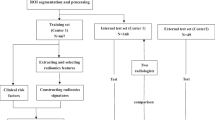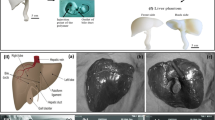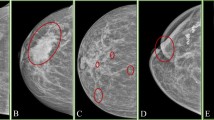Abstract
This study aims to evaluate the feasibility and efficacy of quantitative diagnosis through thermal analysis of abnormal metabolism. In this paper, an analytical-based steady-state solution for the thermal inverse problem was developed, considering an equivalent point heat source embedded in the tissue. Based on this solution, we developed a simple and efficient algorithm that generates solutions for the nonlinear heat conduction model. Using the nonlinear fitting analysis, a regular distribution can be derived from the raw thermal patterns of the skin surface above the tumor, and the power and depth of the equivalent heat source can be derived to investigate whether the tumor is malignant or benign. The thermal power Q of internal heat source was estimated to predict the satisfactory approaches to distinguish between benign and malignant tumors. The results of four clinical cases (female patients with malignant tumor and benign tumor) show that the estimated values of the power of the heat sources in malignant cases (fatty: Q = 0.34851 W; dense: Q = 0.46933 W) are both far greater than the ones in benign (fatty: Q = 0.04721 W; dense: Q = 0.07717 W), irregardless of the breast density. The correlation coefficients (R 2) of the nonlinear curve fittings are all above 0.98. The new thermal method proposed in this study would help to improve the preciseness of diagnosis on breast masses (malignant or benign).





Similar content being viewed by others
References
Siegel, R., Naishadham, D., & Jemal, A. (2013). Cancer statistics, 2013. CA: A Cancer Journal for Clinicians, 63, 11–30.
Bezic, J., Mrklic, I., Pogorelic, Z., & Tomic, S. (2013). Mammographic screening has failed to improve pathohistological characteristics of breast cancers in split region of croatia. Breast Disease, 34, 47–51.
Anbar, M. (1998). Clinical thermal imaging today. IEEE Engineering in Medicine and Biology Magazine, 17, 25–33.
Gautherie, M. (1980). Thermopathology of breast cancer: Measurement and analysis of in vivo temperature and blood flow. Annals of the New York Academy of Sciences, 335, 383–415.
Jones, B. F., & Plassmann, P. (2002). Digital infrared thermal imaging of human skin. IEEE Engineering in Medicine and Biology Magazine, 21, 41–48.
Aupperlee, M., Kariagina, A., Osuch, J., & Haslam, S. Z. (2005). Progestins and breast cancer. Breast Disease, 24, 37–57.
AbdullGaffar, B., Ghazi, E., Mohamed, E., & Hamza, D. (2012). Breast metaplastic carcinoma with unusual small cell component. Breast Disease, 34, 19–24.
Anderson, W. F., Schairer, C., Chen, B. E., Hance, K. W., & Levine, P. H. (2005). Epidemiology of inflammatory breast cancer (IBC). Breast Disease, 22, 9–23.
Absalan, H., SalmanOgli, A., Rostami, R., & Maghoul, A. (2012). Simulation and investigation of quantum dot effects as internal heat-generator source in breast tumor site. Journal of Thermal Biology, 37, 490–495.
Gescheit, I. M., Dayan, A., Ben-David, M., & Gannot, I. (2010). Minimal-invasive thermal imaging of a malignant tumor: A simple model and algorithm. Medical Physics, 37, 211–216.
Jemal, A., Murray, T., Ward, E., Samuels, A., Tiwari, R. C., Ghafoor, A., et al. (2005). Cancer statistics, 2005. CA: A Cancer Journal for Clinicians, 55, 10–30.
Aksel, E. M., & Mikhailov, E. A. (2005). Morbidity statistics of breast cancer in Moscow. Voprosy Onkologii, 51, 656–658.
Allan, A. L., Vantyghem, S. A., Tuck, A. B., & Chambers, A. F. (2006). Tumor dormancy and cancer stem cells: Implications for the biology and treatment of breast cancer metastasis. Breast Disease, 26, 87–98.
Alroy, I., & Yarden, Y. (2000). Biochemistry of HER2 oncogenesis in breast cancer. Breast disease, 11, 31–48.
Brown, K. L., Moglia, D. M., & Grumet, S. (2006). Genetic counseling for breast cancer risk: General concepts, challenging themes and future directions. Breast disease, 27, 69–96.
Chandrasekar, S., Rathi, C. G. P., & Aggarwal, R. (2010). Organophosphate poisoning presenting as acute respiratory distress. Indian Journal of Pediatrics, 77, 1195–1196.
Chavez, K. J., Garimella, S. V., & Lipkowitz, S. (2010). Triple negative breast cancer cell lines: One tool in the search for better treatment of triple negative breast cancer. Breast Disease, 32, 35–48.
Feasey, C. M., Davison, M., & James, W. B. (1971). Effects of natural and forced cooling on the thermographic patterns of tumours. Physics in Medicine & Biology, 16, 213–220.
Carter, P., Fendly, B. M., Lewis, G. D., & Sliwkowski, M. X. (2000). Development of herceptin. Breast Disease, 11, 103–111.
Choudhury, A., & Kiessling, R. (2004). Her-2/neu as a paradigm of a tumor-specific target for therapy. Breast Disease, 20, 25–31.
Lawson, R. N. (1956). Implications of surface temperatures in the diagnosis of breast cancer. Canadian Medical Association Journal, 75, 309–311.
Cowen, R. D., Lawson, R. N., & Saunders, A. L. (1956). Breast cancer and heptaldehyde; preliminary report. Canadian Medical Association Journal, 75, 486–488.
Lawson, R. N. (1958). A new infrared imaging device. Canadian Medical Association Journal, 79, 402–403.
Lawson, R. N. (1964). Early applications of thermography. Annals of the New York Academy of Sciences, 121, 31–33.
Lawson, R. N. (1966). A technique for identifying suitable veins for blood sampling in breast cancer. Canadian Medical Association Journal, 94, 451–453.
Lawson, R. N., & Alt, L. L. (1965). Skin temperature recording with phosphors: A new technique. Canadian Medical Association Journal, 92, 255–260.
Lawson, R. N., & Chughtai, M. S. (1963). Breast cancer and body temperature. Canadian Medical Association Journal, 88, 68–70.
Lawson, R. N., & Gaston, J. P. (1964). Temperature measurements of localized pathological processes. Annals of the New York Academy of Sciences, 121, 90–98.
Poisson, R., Larose, C., Charlebois, S., Pagacz, A., Mercier, J. P., & Lawson, R. N. (1976). Preliminary report on the individualised non-mutilating treatment of operable breast cancer. Clinical Oncology, 2, 55–71.
Draper, J. W., & Jones, C. H. (1969). Thermal patterns of the female breast. British Journal of Radiology, 42, 401–410.
Draper, J. W., & Boag, J. W. (1971). The calculation of skin temperature distributions in thermography. Physics in Medicine & Biology, 16, 201–211.
Draper, J. W., & Boag, J. W. (1971). Skin temperature distributions over veins and tumours. Physics in Medicine & Biology, 16, 645–654.
Davison, M. (1972). Skin temperature distributions over veins and tumours. Physics in Medicine & Biology, 17, 309–310.
Zastrow, E., Hagness, S. C., & Van Veen, B. D. (2010). 3D computational study of non-invasive patient-specific microwave hyperthermia treatment of breast cancer. Physics in Medicine & Biology, 55, 3611–3629.
Chunfang, G., Kaiyang, L., & Shaoping, Z. (2005). A novel approach of analyzing the relation between the inner heat source and the surface temperature distribution in thermal texture maps, Conference proceedings :… Annual international conference of the IEEE Engineering in Medicine and Biology Society. In IEEE engineering in Medicine and Biology Society conference (Vol. 1, pp. 623–626).
Feasey, C. M., James, W. B., & Davison, M. (1970). A technique for breast thermography. British Journal of Radiology, 43, 462–465.
SalmanOgli, A., & Rostami, A. (2012). Modeling and improvement of breast cancer site temperature profile by implantation of onion-like quantum-dot quantum-well heteronanocrystal in tumor site. IEEE Transactions on Nanotechnology, 11, 1183–1191.
He, Y., Zheng, X., Sit, C., Loo, W.T., Wang, Z., Xie T. et al (2012). Using association rules mining to explore pattern of Chinese medicinal formulae (prescription) in treating and preventing breast cancer recurrence and metastasis. Journal of Translational Medicine, 10, S12.
Qian, X., Tucker,A., Gidcumb, E., Lu, J., Zhou, O.,Spronk, D. et al (2012). A stationary digital breast tomosynthesis scanner, in: Proceedings of the SPIE medical imaging, International Society for Optics and Photonics, pp. 831352–831311.
Ye, F., & Shi, G. L. (2013). Clinical breast cancer analysis with surface fitting in the medical thermal texture maps. Applied Mechanics and Materials, 263, 2454–2457.
Liu, K.-C., & Lin, C.-N. (2010). Temperature prediction for tumor hyperthermia with the behavior of thermal wave. Numerical Heat Transfer, Part A, 58, 819–833.
Erb, K. M., Shapiro-Wright, H. M., & Julian, T. B. (2010). Axillary recurrences following positive sentinel lymph node biopsy with individual tumor cells or micrometastases and no axillary dissection. Breast disease, 31, 83–90.
Farese, S. A., & Aebi, S. (2008). Infiltrating lobular carcinoma of the breast: Systemic treatment. Breast disease, 30, 45–52.
Pennes, H. H. (1948). Analysis of tissue and arterial blood temperatures in the resting human forearm. Journal of Applied Physiology, 1, 93–122.
Acknowledgments
This work was financially supported by grants from the National Major Special Program of Scientific Instrument & Equipment Development of China (No. 2012YQ160203) and the first author also thanks financial supports by the Fundamental Research Funds for the Center Universities of China (No. 2011120202020006).
Conflict of interest
None.
Author information
Authors and Affiliations
Corresponding author
Rights and permissions
About this article
Cite this article
Han, F., Shi, G., Liang, C. et al. A Simple and Efficient Method for Breast Cancer Diagnosis Based on Infrared Thermal Imaging. Cell Biochem Biophys 71, 491–498 (2015). https://doi.org/10.1007/s12013-014-0229-5
Published:
Issue Date:
DOI: https://doi.org/10.1007/s12013-014-0229-5




